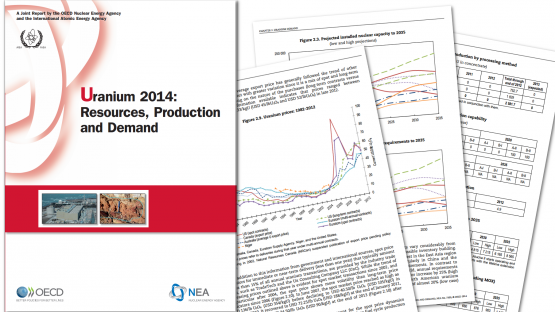Demand for uranium, the raw material used to fuel nuclear power stations around the globe, will continue to rise in the foreseeable future, despite declining market prices since the Fukushima Daiichi Nuclear Power Plant accident in Japan in March 2011 and lower electricity demand as a result of the global economic crisis. These are among the key findings of an authoritative world reference report on uranium published today by the International Atomic Energy Agency (IAEA) and the Nuclear Energy Agency (NEA) of the Organisation for Economic Co-operation and Development (OECD).
Solid Growth of Supply and Production
The Red Book, as the publication is known, also finds an increase in uranium supply, exploration and production. Some seven per cent more uranium resources have been identified since the last report was published in 2012, adding almost 10 years to the existing resource base. Global uranium production continued to increase between 2010 and 2012, albeit at a lower rate than in the previous two-year period. The growth in the resource base is mainly due to a 23 per cent increase in uranium exploration and mine development, which totalled US $1.92 billion in 2012.
On the demand side, projections vary from region to region. While the Fukushima Daiichi nuclear accident resulted in a change of policies in many developed countries, nuclear capacity projections, notably in East Asia and non-European Union states on the European continent, continue to grow. The Red Book projects that world nuclear electricity generating capacity by 2035 is expected to increase between 7 per cent on the low and 82 per cent on the high side. This is in line with the IAEA's most recent projections of between 8 and 88 per cent for the year 2030.
Geographic Resource Spread
More than 20 countries around the globe produce uranium, with Kazakhstan, Canada and Australia as the largest producers, accounting for approximately 63 per cent of world production. The reported growth in production is mainly driven by Kazakhstan, with smaller additions in Australia, Brazil, China, Malawi, Namibia, Niger, Ukraine and the United States. The continued robust demand for the resource has led to future plans for mining operations in new countries including Botswana, Tanzania and Zambia. To minimise the social and environmental impacts, efforts are being made to develop transparent, safe, secure and well-regulated operations in these areas, activities on which the Red Book reports in its individual country chapters.
Background
Uranium 2014: Resources, Production and Demand, the 25th edition of the Red Book, is a recognised world reference on uranium jointly prepared by the OECD/NEA and the IAEA. This edition provides analyses and information from 45 producing and consuming countries in order to address questions on data on global uranium exploration, resources, production and reactor-related requirements. It offers updated information on established uranium production centres and mine development plans, as well as projections of nuclear generating capacity and reactor-related requirements through 2035, incorporating policy changes following the Fukushima nuclear accident, in order to address long-term global uranium supply and demand issues.


